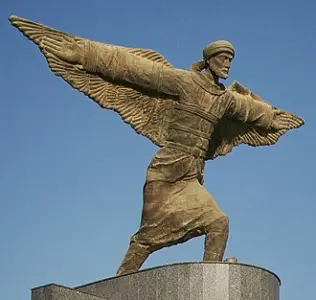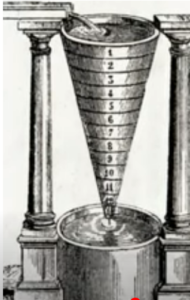Abbas ibn Firnas : The first aviator
Do you know that the relationship between wings and a tail to stabilise flight first developed by Abbas Ibn Firnas which contributed to the success of the Wright brothers’ flying machine in 1903?
Who was Abbas ibn Firnas?
Abbas ibn Firnas was a Berber Andalusian polymath: an inventor, astronomer, physician, chemist, engineer, Andalusi musician, and Arabic-language poet.
Abbas Ibn Firnas was born in Al-Andalusia (Now it is Ronda, Spain) in 810 and was a Muslim. His family belongs to the Berber tribe who are famous for conquering Spain in the leadership of Tariq Bin Ziyad. Spain of that time was under the control of Muslims and was a glorious nation due to the institution of science and technology.
Full name : Abu al-Qasim Abbas ibn Firnas ibn Wirdas al-Takurini .
Abbas ibn Firnas Timeline
| Ibn Abbas Birth | 810 AD |
| Ibn Abbas made his first flying machine in the year 875 | 875 |
| Death | 887 AD |
| A statue of Ibn Firnas by the sculptor Badri al-Samarrai was installed at the Baghdad International Airport in Iraq | 1973 |
| The International Astronomical Union (IAU) approved of naming a crater on the moon after him as Ibn Firnas | 1976 |
| One of the bridges going over the Guadalquivir river in Córdoba, Spain, was named the “Abbas Ibn Firnás Bridge | 2011 |

Abbas ibn Firnas Achievements
Abbas ibn Firnas is best known for being the world’s first pilot. Abbas ibn Firnas created the first glider, which inspired other inventors, the Wright brothers, to build the first aeroplane. This was built on the many years of research that Abbas ibn Firnas had documented in a book. His achievement was recognised in 1979, by the Working Group for Planetary Systems Nomenclature (IAU / WGPSN) when they named a crater, ‘Ibn Firnas’, on the moon in his honour.
Also read : Motivational Muslim Series
One day, he watched the first parachute test jump, and studied the nature of flight for the next 23 years. This eventually led up to him at age 70 building a pair of wings made of silk, wood and feathers. He jumped off a cliff and glided in the air for 10 minutes, proving his work to be a success.
Abbas ibn Firnas gliding attempt
Ibn Firnas recognized that the key to achieving flight lay in generating enough lift to support his own weight. To this end, he embarked on the construction of wings with a span estimated to be between four and five meters. His determination to strike the delicate balance between strength and weight led him to choose a lightweight wooden frame, likely fashioned from bamboo. The bamboo’s hollow structure, akin to the bones of a bird’s wing, held promise for enhancing the aerodynamic efficiency of his creation.
What truly set Ibn Firnas’ gliding attempt apart was his meticulous choice of materials. Delicate silk strips served as the intricate threads that wove his contraption together. Silk, renowned for its exceptional lightweight and robust characteristics during that era, provided the perfect binding agent for the components of his wings. This same silk fabric was meticulously stretched over the framework, forming the intricate surface of the wings. To add the finishing touch, Ibn Firnas adorned his wings, as well as his own attire, with the majestic plumage of eagle feathers.
Ibn Firnas’ innovation extended beyond the construction of the wings. A brilliant mind attuned to both engineering and ergonomics, he designed a harness system that allowed him to be suspended beneath the flying apparatus. This ingenious arrangement gave him the ability to manipulate the wing movements through strategically positioned handles. However, considering that Ibn Firnas was already 70 years old at the time of his attempt, his physical limitations likely constrained the full range of wing motions.
Abbas ibn Firnas flying machine:
In the annals of history, it is recorded that Ibn Firnas’ audacious flight took off from an elevated position, soaring through the air for a considerable span of time. This achievement attests to the effectiveness of his gliding mechanism, which exhibited commendable gliding capabilities.
Upon landing, however, he damaged the wings and injured his back. This has been ascribed to the fact that the flying machine lacked a tail, which possibly limited his machine’s lateral control and body posture.
He lived another 12 years after his flight and continued his studies in avionics. Though he did not make another attempt to fly, he studied the shortcomings of his landing and came to the conclusion that besides wings there is a necessity of having a tail to act a rudder to control flight.

Abbas ibn Firnas flying aspirations
Others who were inspired by Abbas bin Firnas’ example:
Although his flight attempt was not entirely successful, Abbas ibn Firnas’s courage and determination in attempting human flight were influential. His early experiments and insights into aerodynamics paved the way for later aviators and engineers, who built upon his work and eventually made significant advancements in the field of aviation.
- Abu al-Nasr Ismael Al-Johari, 11th century Turkistan. Using wings made of wood and rope, this teacher from Nishapur launched himself from the minaret of the Ulu Mosque and fell to his death
- Eilmer of Malmesbury, 11th century England. Word of Abbas bin Firnas reached this English monk and he tried to fly by jumping from a tower.
- Leonardo da Vinci (1452-1519) researched the mechanics of flight in depth and designed flying machines such as ornithopters, gliders and helicopters.
- Hazarfen Ahmed Celebi (1611-1682) a renowned Turkish flyer flew successfully over the Bosporus on wings of eagle feathers, similar to Abbas bin Firnas.
- 1000 years after Abbas bin Firnas’s adventure, the flying machine has evolved into the modern glider.
- In Germany in the 1890s, Otto Lilienthal developed sophisticated and functional gliding machines that paved the way for the development of the first powered flying machines a decade later.
- His developments regarding the stability and control of gliders contributed much to the success of the Wright brothers’ flying machine in 1903. Once the principles of aerodynamics were fully mastered in the 20th century, mankind could finally fulfil his dreams of mastering the skies.
He devised a means of manufacturing colorless glass, invented various glass planispheres, made corrective lenses (“reading stones”), devised a chain of things that could be used to simulate the motions of the planets and stars, and developed a process for cutting rock crystal that allowed Spain to cease exporting quartz to Egypt to be cut.
Abbas ibn Firnas achievements and inventions
He devoted his entire life to science and wrote many books on mathematics, physics, astronomy and engineering that were taught in the University of Al-Andalusia. His book describing his first flight and the lessons learnt went on to inspire many more who endeavoured to fly, including Leonardo Da Vinci.
He even became one of the first teachers at the famous Cordovan school of music run by the Iraqi musician, Ziryab.
Summary of Achievement of Abbas ibn Firnas
- Early Aviation Pioneer: He is credited with one of the earliest attempts at human flight. In the 9th century, he constructed a pair of wings made of silk and feathers and attempted to fly from a tower in Cordoba, Spain. Though his flight was not entirely successful, he managed to glide for a short distance before landing safely. His feat earned him recognition as one of the earliest aviation pioneers in history.
- Planetarium: In addition to his attempt to fly, Abbas studied astronomy and designed a mechanized planetarium that had revolving planets that moved in relation to each other as they do in the universe. He conducted extensive studies in these disciplines, making advancements in celestial observations and mapmaking.
- He also experimented with crystal, quartz and sand to create transparent glass of high quality that was used for making famous Andalusian glasses for drinking water. He further studied the magnifying properties of glass and made lenses for correcting eyesight.
- He is also known to have designed a water clock called Al-Maqata for keeping track of time. His other contribution was to devise a means of cutting rock crystal that was only known in Egypt at that time.
- Ibn Firnas Music: Ibn Firnas was also a poet and a skilled musician. He was a prominent figure in the cultural and intellectual circles of his time and was known for his patronage of artists and scholars. Abbas Ibn Firnas learned music and Arabic poetry from a famous Iraqi musician of that time, Ziryab.
Al Maqata-Abbas ibn Firnas water clock

Also read : 5 Facts about Abu Zayd al Balkhi, the Muslim psychologist who was the first to diagnose mental illness.
Ref : Wiki
Discover more from Islam Hashtag
Subscribe to get the latest posts sent to your email.




